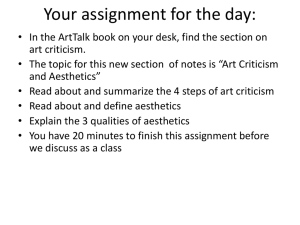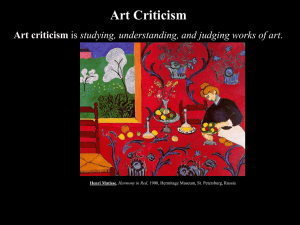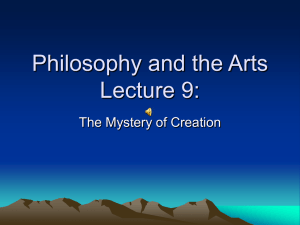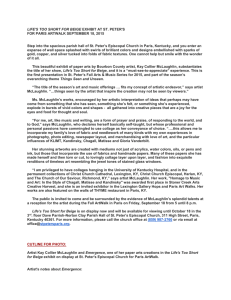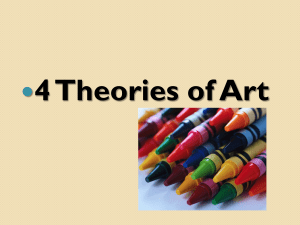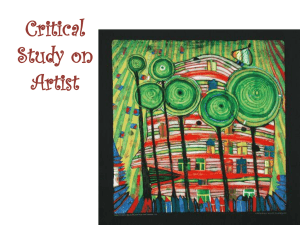How to Analyze a Painting Power Point
advertisement
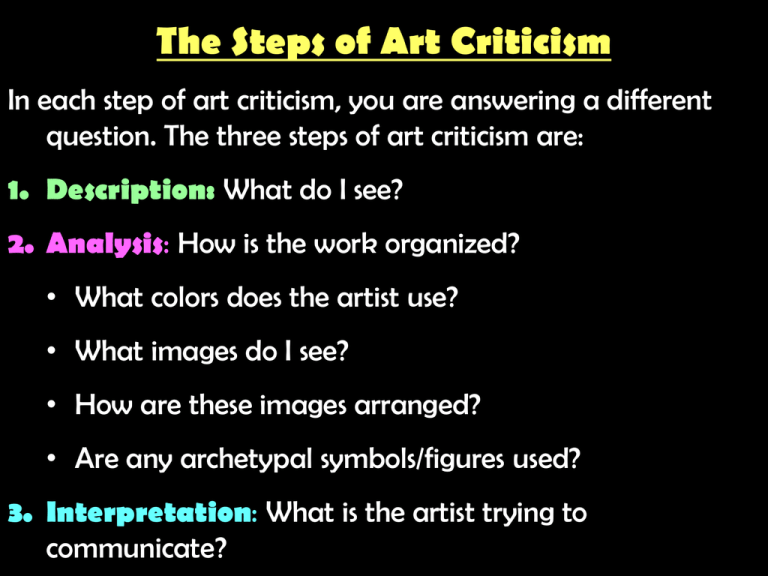
The Steps of Art Criticism In each step of art criticism, you are answering a different question. The three steps of art criticism are: 1. Description: What do I see? 2. Analysis: How is the work organized? • What colors does the artist use? • What images do I see? • How are these images arranged? • Are any archetypal symbols/figures used? 3. Interpretation: What is the artist trying to communicate? Understanding Art Criticism Art criticism is studying, understanding, and evaluating works of art. •What if you don’t know what an artwork is communicating? •How can you figure it out? Following the steps of art criticism can help you discover lots of clues to really understand and appreciate a work of art. Paris Through the Window by Marc Chagall Description: What do I see? • A cat • A ledge • A man with 2 faces • The Eiffel tower • A window • A man in the sky • Buildings Analysis: How is the work organized? • What colors does the artist use? • What images do I see? • How are these images arranged? • Are any archetypal images/symbols used? Analysis: How is the work organized? • What colors does the artist use? • Rainbow • Yellow • Blue • Red • Green • Brown • Grey • White Analysis: How is the work organized? • What images do I see? (similar to #1) • A cat • A ledge • A man with 2 faces • The Eiffel tower • A window • A man in the sky • Buildings Analysis: How is the work organized? • How are these images arranged? • Colors in the foreground • Cat in the foreground looking out (at ET?) • Man with two faces holding a heart in the foreground • Eiffel Tower in background yet the eye is drawn there Analysis: How is the work organized? Are any archetypal images or symbols used? Archetypal image: Recurrent image that is universal & expresses human nature or experiences • White: innocence, purity, light (the city and tower) • Yellow: brightness, happiness • Blue: positivity, truth • Red: passion, love, violence • Green: life, rebirth, growth • Brown: earth tones, unity with land Interpretation: What is the artist trying to communicate? Possible Conclusions: The artist is depicting his vision of Paris. The artist uses the element of color to add visual interest to the painting and express how he feels about the subject (Paris). The cat represents the artist looking out at Paris. This seems like a very happy time/place for the artist. The artist is most likely communicating his positive feelings about Paris. "Odysseus in the Cave of Polyphemus" by Jacob Jordaens Directions: On a sheet of notebook paper, please write 1 paragraph (6-8 sentences) comparing or contrasting the painting to the text. You may choose to write your paragraph comparing or contrasting: Step 1: Choose your claim • Compare claim: The painting “Odysseus in the Cave of Polyphemus” by Jacob Jordaens is similar to the story of the Cyclops by Homer. • Contrast claim: The painting “Odysseus in the Cave of Polyphemus” by Jacob Jordaens is different from the story of the Cyclops by Homer. Step 2: Choose your evidence • At least 2 pieces of evidence o 1 piece of evidence from the painting(color, placement, archetypal image) o 1 piece of evidence from the story (plot event, characterization, adjectives, details) Step 3: Analyze your evidence to prove your claim Tilla Durieux as Circe by Franz von Stuck Circe entertaining Odysseus at a Banquet by Giovanni Paolo Pannini, 1718 Circe Indiviosa by John Williams Watergate
